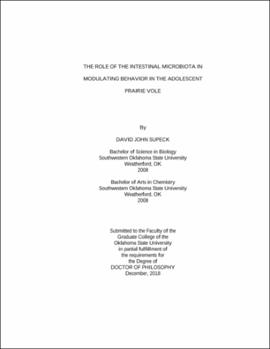| dc.contributor.advisor | Koehler, Gerwald A. | |
| dc.contributor.author | Supeck, David John | |
| dc.date.accessioned | 2021-08-03T19:05:57Z | |
| dc.date.available | 2021-08-03T19:05:57Z | |
| dc.date.issued | 2018-12 | |
| dc.identifier.uri | https://hdl.handle.net/11244/330192 | |
| dc.description.abstract | Introduction: The intestinal epithelium develops during gestation and goes through many changes shortly after birth. During this time period the intestinal epithelium matures into a selective barrier to protect the host while still allowing the passage of required nutrition. Meanwhile, at birth, human and rodent intestines are colonized with microorganisms from their mother and the environment. The intestinal tract will ultimately contain trillions of resident bacteria with the colon having the greatest number of microbes. By far the largest portion of the human microbiota colonizes the intestine and plays a crucial role in maintaining the health of their host. Alterations in the bacterial communities can create an imbalance in microbial populations, which is termed dysbiosis. The intestinal microbiota is engaged in bidirectional communication with the central nervous system (CNS) and changes in the microbiota have been correlated with mood and anxiety disorders. The highly social prairie vole, Microtus ochrogaster, is an emerging model organism for studying the intestinal microbiota's influence on (social) behavior via the microbiota-gut-brain-behavior axis. | |
| dc.description.abstract | Methods: In order to learn more about the microbiota-host relationship in the prairie vole, intestinal barrier functioning and maturation was characterized by measuring paracellular absorption of 4 kDa FITC-dextran molecules and tight junction gene expression profiles. Subsequently, prairie voles were treated with neomycin to induce alterations in the intestinal microbiota. Fecal DNA was extracted and the compositional changes characterized using terminal restriction-fragment polymorphism analysis (T-RFLP) and next-generation sequencing of 16S rRNA genes. The effects of microbial composition shifts induced by neomycin on behavior in prairie voles were evaluated using the elevated plus maze (EPM) and forced swim test (FST). | |
| dc.description.abstract | Results: These results indicate that intestinal barrier function maturation occurs by three weeks of age and is associated with changes in the gene expression of tight junction proteins. T-FRLP and sequencing showed that neomycin treatment resulted in decreasing intestinal microbial diversity. Of interest was the decrease in lactic acid bacteria in the neomycin group. Neomycin treated prairie voles exhibited a depressive-like behavior. | |
| dc.description.abstract | Conclusion: These results indicate that microbiota play an important role in the behavior of prairie voles and that microbiota shifts induced by neomycin are correlated with depressive-like behavior. | |
| dc.format | application/pdf | |
| dc.language | en_US | |
| dc.rights | Copyright is held by the author who has granted the Oklahoma State University Library the non-exclusive right to share this material in its institutional repository. Contact Digital Library Services at lib-dls@okstate.edu or 405-744-9161 for the permission policy on the use, reproduction or distribution of this material. | |
| dc.title | Role of the intestinal microbiota in modulating behavior in the adolescent prairie vole | |
| dc.contributor.committeeMember | Teague, T. Kent | |
| dc.contributor.committeeMember | Wilson, Nedra | |
| dc.contributor.committeeMember | Miller, Robert | |
| dc.contributor.committeeMember | Payton, Mark | |
| osu.filename | Supeck_okstate_0664D_16058.pdf | |
| osu.accesstype | Open Access | |
| dc.type.genre | Dissertation | |
| dc.type.material | Text | |
| dc.subject.keywords | colon epithelial barrier | |
| dc.subject.keywords | depression | |
| dc.subject.keywords | microbiome | |
| dc.subject.keywords | microtus ochrogaster | |
| dc.subject.keywords | prairie vole | |
| dc.subject.keywords | tight junctions | |
| thesis.degree.discipline | Biomedical Sciences | |
| thesis.degree.grantor | Oklahoma State University | |
